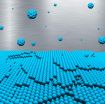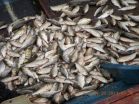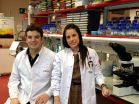Scientists prove possibility of 'impossible' dust transition in turbulent flow
2014-11-05
(Press-News.org) Researchers from MIPT and the Weizmann Institute of Science (Israel) have predicted the possibility of negative turbophoresis, a phenomenon where impurity particles inside a turbulent flow move in an "impossible" direction. The study by Sergei Belan (a postgraduate at MIPT), Grigory Falkovich and Itzhak Fouxon was published in the journal Physical Review Letters in the Editors' Suggestions section, which features the most important and interesting studies from the editorial board's point of view.
The researchers studied the behavior of inertial particles in different environments where they were exposed to random forces. Examples of such systems include Brownian particles in a thermostat (a heated fluid, for example), dust particles and aerosols in turbulent gas flows. In the case of Brownian motion, a random force emerges due to chaotic collisions of the molecules of a thermostat.
A particle in a turbulent flow is subjected to Stokes' law of friction force, which is proportional to the difference of the velocities of the particle and fluid at the point considered. Since the velocity of turbulent gas changes chaotically, the resultant frictional force can also be considered chaotic. It has been known since Maxwell's time that the heterogeneity of thermostat temperatures (i.e. the heterogeneity of the intensity of a random force) makes particles flow in the direction of lower temperatures. This phenomenon, called thermophoresis, is very common in nature and is used in a number of devices.
A typical example is the blackening of the surface of an oil lamp: the temperature gradient "pushes" soot particles away from the flame, which makes them deposit on the glass of the lamp. The thermophoresis effect is used to manipulate nanoparticles and to clean air from submicron-size particles. In the case of inertial particles in turbulent flows, a similar effect called turbophoresis is observed. This phenomenon emerges, for example, when dust and aerosols move in the atmosphere, when reagents are stirred in chemical reactors or when impurity particles deposit on tubes.
For many years it was believed that thermophoresis / turbophoresis inevitably leads to the accumulation of particles in the field of low temperatures / low turbulence. The generally accepted view was that particles in a turbulent flow always migrate towards the walls. The new article says this was an erroneous conclusion. Having examined the behavior of particles near the minimum of turbulence, the researchers showed the possibility of negative turbophoresis for sufficiently heavy particles when the flow moves towards greater intensity. The theoretical model they presented allows for determining the critical value of the inertia, wherein the sign of the particle flow changes from positive to negative.
As the researchers explained in their paper, this is a new type of phase transition: depending on the parameter of inertia the cloud of inertial particles is either localized, concentrating near the minimum of turbulence, or delocalized, leaving the vicinity of this minimum. Now the most interesting question is how accurately the proposed theoretical model describes the behavior of particles in real turbulent flows. At the moment, the researchers are seeking confirmation of the effect they predicted.
INFORMATION:
[Attachments] See images for this press release:

ELSE PRESS RELEASES FROM THIS DATE:
2014-11-05
An international study has devised a new measure for the "livability" of major cities across the world. The Global Liveable Cities Index (GLCI) takes into account the sensibilities of ordinary working people from 64 cities, balancing work and play, environmental awareness, localism, globalism and many other factors. Details are published in the World Review of Science, Technology and Sustainable Development.
According to Tan Khee Giap of the National University of Singapore and colleagues at University of California, Davis, and Curtin University, in Bentley, Australia, ...
2014-11-05
In a recent paper published in Nature Nanotechnology, Joel Moser and ICFO colleagues of the NanoOptoMechanics research group led by Prof. Adrian Bachtold, together with Marc Dykman (Michigan University), report on an experiment in which a carbon nanotube mechanical resonator exhibits quality factors of up to 5 million, 30 times better than the best quality factors measured in nanotubes to date.
Imagine that the host of a dinner party tries to get his guests' attention by giving a single tap of his oyster spoon on his crystal glass. Now, imagine, to the amazement of all, ...
2014-11-05
New Danish-led research suggests that signs of brain aging can be postponed in mice if placed on a high-fat diet. In the long term, this opens the possibility of treatment of children suffering from premature aging and patients with Alzheimer's and Parkinson's disease. The research project is headed by the Center for Healthy Aging, University of Copenhagen and the National Institute of Health.
When we get older, defects begin to develop in our nervous system, our brain loses some of its intellectual capacity, and the risk of developing diseases such as Parkinson's and ...
2014-11-05
Using DESY's ultrabright X-ray source PETRA III, researchers have observed in real-time how football-shaped carbon molecules arrange themselves into ultra-smooth layers. Together with theoretical simulations, the investigation reveals the fundamentals of this growth process for the first time in detail, as the team around Sebastian Bommel (DESY and Humboldt Universität zu Berlin) and Nicola Kleppmann (Technische Universität Berlin) reports in the scientific journal Nature Communications. This knowledge will eventually enable scientists to tailor nanostructures ...
2014-11-05
Researchers at the Cognition and Brain Plasticity group of the Bellvitge Biomedical Research Institute (IDIBELL) and the University of Barcelona have been tracking the traces of implicit and explicit memories of fear in human. The study has been published in the journal Neurobiology of Learning and Memory and describes how in a context of fear, our brain differently encodes contextual memory of a negative event (the place, what we saw...) and emotional response associated.
The study measures electrodermal activity of 86 individuals in a fearful generated in the laboratory ...
2014-11-05
Bethesda, MD (Nov. 5, 2014) — Up to 15 percent of the general adult population is affected by irritable bowel syndrome (IBS), and most patients struggle to find effective drug therapy. A new guideline from the American Gastroenterological Association (AGA) provides these patients and their physician's guidance. The new guideline and accompanying technical review have been published in Gastroenterology, the official journal of the AGA Institute.
"Because no IBS therapy is uniformly effective, many patients describe a history of a variety of treatments alone or in ...
2014-11-05
What sounds counter-intuitive to an activity commonly perceived as quiet is the broad recommendation of scientists at Michigan State University (MSU) recommending that small-scale fishing in the world's freshwater bodies must have a higher profile to best protect global food security.
In this month's journal Global Food Security, scientists note that competition for freshwater is ratcheting up all over the world for municipal use, hydropower, industry, commercial development, and irrigation. Rivers are being dammed and rerouted, lakes and wetlands are being drained, fish ...
2014-11-05
Noonan syndrome is a rare disease that is characterised by a set of pathologies, including heart, facial and skeletal alterations, pulmonary stenosis, short stature, and a greater incidence of haematological problems (mainly juvenile myeloid leukaemia, or childhood leukaemia). There is an estimated incidence of 1 case for every 1,000–2,500 births, and calculations show some 20,000–40,000 people suffer from the disease in Spain. From a genetic point of view, this syndrome is associated to mutations in 11 different genes —the K-Ras gene among them— ...
2014-11-05
PATIENTS with a specific type of oesophageal cancer survived longer when they were given the latest lung cancer drug, according to trial results being presented at the National Cancer Research Institute (NCRI) Cancer Conference today (Wednesday).
Up to one in six patients with oesophageal cancer were found to have EGFR duplication in their tumour cells and taking the drug gefitinib, which targets this fault, boosted their survival by up to six months, and sometimes beyond.
This is the first treatment for advanced oesophageal cancer shown to improve survival in patients ...
2014-11-05
Fatih Uckun, Jianjun Cheng and their colleagues have taken the first steps towards developing a so-called "smart bomb" to attack the most common and deadly form of childhood cancer — called B-lineage acute lymphoblastic leukemia (ALL).
In a November study in the new peer-reviewed, open-access journal EBioMedicine, they describe how this approach could eventually prove lifesaving for children who have relapsed after initial chemotherapy and face a less than 20 percent chance of long-term survival.
"We knew that we could kill chemotherapy-resistant leukemia cells ...
LAST 30 PRESS RELEASES:
[Press-News.org] Scientists prove possibility of 'impossible' dust transition in turbulent flow






